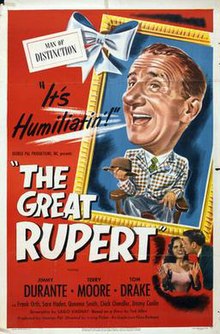
James Francis Durante was an American comedian, actor, singer, and pianist. His distinctive gravelly speech, Lower East Side accent, comic language-butchery, jazz-influenced songs, and prominent nose helped make him one of the United States' most familiar and popular personalities of the 1920s through the 1970s. He often referred to his nose as the schnozzola, and the word became his nickname.

Thomas J. Moore was an Irish-American actor and director. He appeared in at least 186 motion pictures from 1908 to 1954. Frequently cast as the romantic lead, he starred in silent movies as well as in some of the first talkies.

Destination Moon is a 1950 American Technicolor science fiction film, independently produced by George Pal and directed by Irving Pichel, that stars John Archer, Warner Anderson, Tom Powers, and Dick Wesson. The film was distributed in the United States and the United Kingdom by Eagle-Lion Classics.

Jonathan Joseph "Candy" Candido was an American radio performer and voice actor. He was best remembered for his famous line "I'm feeling mighty low".

Terry Moore is an American film and television actress who began her career as a child actor. She was nominated for the Academy Award for Best Supporting Actress for her performance in Come Back, Little Sheba (1952).

Tom Drake was an American actor. Drake made films starting in 1940 and continuing until the mid-1970s, and also made TV acting appearances.

That Gang of Mine is a 1940 film directed by Joseph H. Lewis and starring Leo Gorcey and Bobby Jordan. It is the third film in the East Side Kids series.

Mighty Joe Young is a 1949 American black and white fantasy film distributed by RKO Radio Pictures and produced by the same creative team responsible for King Kong (1933). The film was produced by Merian C. Cooper, directed by Ernest B. Schoedsack, and Ruth Rose wrote the screenplay. It stars Robert Armstrong, Terry Moore, and Ben Johnson in his first credited screen role. Animation effects were handled by Ray Harryhausen, Pete Peterson and Marcel Delgado.

Taylor Holmes was an American actor who appeared in over 100 Broadway plays in his five-decade career. However, he is probably best remembered for his screen performances, which he began in silent films in 1917.

Curious George is an American children's animated television series based on the children's book series of the same name for PBS Kids which features Jeff Bennett as the voice of Ted Shackelford. Frank Welker, who voiced George in the 2006 feature film, reprises the role in the series. The show premiered on PBS Kids on September 4, 2006, and originally ended after nine seasons on April 1, 2015 before returning in 2018.

Jimmy Conlin was an American character actor who appeared in almost 150 films in his 32-year career.

It's Great to Be Young is a 1956 British Technicolor musical comedy film about a school music teacher, starring Cecil Parker and John Mills.

Irving Pichel was an American actor and film director, who won acclaim both as an actor and director in his Hollywood career.
The following is a list of players, both past and current, who appeared at least in one game for the Cincinnati Reds National League franchise, also known previously as the Cincinnati Red Stockings (1882–1889) and Cincinnati Redlegs (1953–1958). Players in Bold are members of the National Baseball Hall of Fame.
The 1973 British League Division Two season was the second tier of motorcycle speedway in Great Britain.

Speed is a 1936 Metro-Goldwyn-Mayer action film directed by Edwin L. Marin. It starred James Stewart, in his first starring role, and Wendy Barrie. Although only a low-budget "B" movie, the film was notable for its realistic cinematography by Lester White, incorporating scenes from the Indianapolis 500 race and on-location shooting at the Muroc dry lake bed, used for high-speed racing by "hot rodders" in the 1930s. Advance publicity trumpeted that Stewart drove the specially-prepared "Falcon" to 140 mph (230 km/h).

Jerky Turkey is a 1945 Metro-Goldwyn-Mayer cartoon directed by Tex Avery. Jerky Turkey is one of three MGM cartoons in the public domain in the United States as its copyright was not renewed.
Wilson D. "Pete" Burness was an American animator and animation director. He was perhaps best known for his work on the Mr. Magoo series. He also contributed to the Tom and Jerry series, Looney Tunes, Merrie Melodies, and Rocky and His Friends.

Gambling House is a 1951 American film noir crime film directed by Ted Tetzlaff and starring Victor Mature, Terry Moore and William Bendix.
Events in 1917 in animation.
















